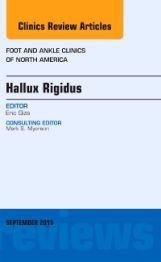Hallux Rigidus, An issue of Foot and Ankle Clinics of North America, 1st Edition
Author :
Eric Giza
In the MTP joint, as in any joint, the ends of the bones are covered by a smooth articular cartilage. If wear-and-tear or injury damage the articular cartilage, the raw bone ends can rub together. A bone spur, or overgrowth, may develop on the top of
...view more
In the MTP joint, as in any joint, the ends of the bones are covered by a smooth articular cartilage. If wear-and-tear or injury damage the articular cartilage, the raw bone ends can rub together. A bone spur, or overgrowth, may develop on the top of the bone. This overgrowth can prevent the toe from bending as much as it needs to when you walk. The result is a stiff big toe, or hallux rigidus. Hallux rigidus usually develops in adults between the ages of 30 and 60 years. No one knows why it appears in some people and not others. It may result from an injury to the toe that damages the articular cartilage or from differences in foot anatomy that increase stress on the joint.
In the MTP joint, as in any joint, the ends of the bones are covered by a smooth articular cartilage. If wear-and-tear or injury damage the articular cartilage, the raw bone ends can rub together. A bone spur, or overgrowth, may develop on the top of the bone. This overgrowth can prevent the toe from bending as much as it needs to when you walk. The result is a stiff big toe, or hallux rigidus. Hallux rigidus usually develops in adults between the ages of 30 and 60 years. No one knows why it appears in some people and not others. It may result from an injury to the toe that damages the articular cartilage or from differences in foot anatomy that increase stress on the joint.
Author Information
By Eric Giza, MD, Chief of the UC Davis Orthopaedics/Foot and Ankle Service
Lawrence J. Ellison Ambulatory Care Center, Orthopaedic Surgery
| ISBN Number | 9780323395632 |
|---|---|
| Main Author | By Eric Giza, MD |
| Copyright Year | 2015 |
| Edition Number | 1 |
| Format | Book |
| Trim | 152w x 229h (6.00" x 9.00") |
| Imprint | Elsevier |
| Page Count | 0 |
| Publication Date | 9 Sep 2015 |
| Stock Status | IN STOCK - This may take up to 5 business days to ship |
Write Your Own Review
Only registered users can write reviews. Please sign in or create an account
product
https://www.us.elsevierhealth.com/hallux-rigidus-an-issue-of-foot-and-ankle-clinics-of-north-america-9780323395632.html
1868
Hallux Rigidus, An issue of Foot and Ankle Clinics of North America
https://www.us.elsevierhealth.com/media/catalog/product/9/7/9780323395632.jpg
74.24
98.99
USD
InStock
/Medicine/Orthopaedics
/Clinics
/Clinics
66
4388725
5255041
1
3
8
4182692
5145120
In the MTP joint, as in any joint, the ends of the bones are covered by a smooth articular cartilage. If wear-and-tear or injury damage the articular cartilage, the raw bone ends can rub together. A bone spur, or overgrowth, may develop on the top of the bone. This overgrowth can prevent the toe from bending as much as it needs to when you walk. The result is a stiff big toe, or hallux rigidus. Hallux rigidus usually develops in adults between the ages of 30 and 60 years. No one knows why it appears in some people and not others. It may result from an injury to the toe that damages the articular cartilage or from differences in foot anatomy that increase stress on the joint. In the MTP joint, as in any joint, the ends of the bones are covered by a smooth articular cartilage. If wear-and-tear or injury damage the articular cartilage, the raw bone ends can rub together. A bone spur, or overgrowth, may develop on the top of the bone. This overgrowth can prevent the toe from bending as much as it needs to when you walk. The result is a stiff big toe, or hallux rigidus. Hallux rigidus usually develops in adults between the ages of 30 and 60 years. No one knows why it appears in some people and not others. It may result from an injury to the toe that damages the articular cartilage or from differences in foot anatomy that increase stress on the joint.
0
0
add-to-cart
9780323395632
2015
Professional
By Eric Giza, MD
2015
1
Book
152w x 229h (6.00" x 9.00")
Elsevier
0
Sep 9, 2015
IN STOCK - This may take up to 5 business days to ship
By <STRONG>Eric Giza</STRONG>, MD, Chief of the UC Davis Orthopaedics/Foot and Ankle Service
Lawrence J. Ellison Ambulatory Care Center, Orthopaedic Surgery
Clinics
Clinics
The Clinics: Orthopedics
No
No
No
No
Please Select
Please Select
Please Select
Related Products
-
20% OFF
 Flash Cards
Flash Cards
-
20% OFF
 Online Resource
Netter's Dissection Video Modules (Retail Access Card)
Online Resource
Netter's Dissection Video Modules (Retail Access Card)University of North Carolina Chapel Hill and Frank H. Netter
Oct 2015
Special Price $144.79 $180.99 -
20% OFF
 Book
Nolte's The Human Brain in Photographs and Diagrams
Book
Nolte's The Human Brain in Photographs and DiagramsTodd W. Vanderah
Jan 2019
Special Price $51.19 $63.99 -
20% OFF
 Book
Book
-
20% OFF
 Book
Book
-
20% OFF
 Flash Cards
Flash Cards
-
20% OFF
 Book
Book
-
20% OFF
 Book
Book
-
20% OFF
 Book
Book
-
20% OFF
 Flash Cards
Flash Cards




